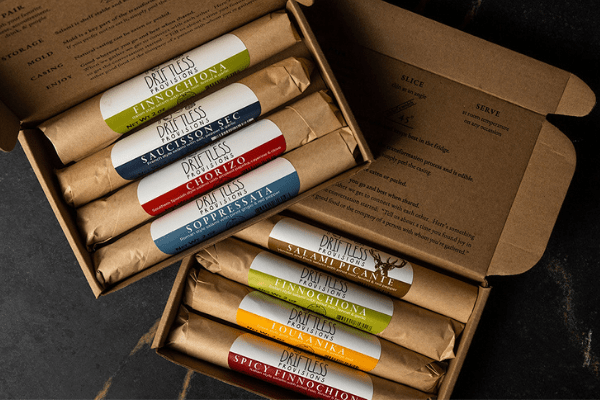Launching a processed meat business isn’t quick, easy or cheap. It can take many months, even years, to generate funding, develop a great product for market, dial in a brand proposition, lock down a viable co-packer or your own facility and equipment, secure distribution, and get your name and products in front of consumers.
It also takes time just to amass the wherewithal to know what you’re doing. If you haven’t been in and around meat production or processing for many years—even if you have been—this business has a steep learning curve.
All that considered, there is immense opportunity in meat products and, if you’re passionate about it, many reasons to give it a go. For one, there is market demand. Despite all the headlines about consumers abandoning meat, data show that just isn’t true. Meat sales broke records in 2020, surging 19% over 2019 numbers. A whopping 98% of U.S. households purchased meat last year.
What is changing, however, is the types of meat products consumers are buying. There has been a big reckoning in recent years over where meat comes from and how its production impacts the environment, prompting many people to seek out smaller-source, locally produced, ethically raised options. The COVID-19 pandemic has only intensified this demand by ransacking meat supply chains and exposing the food system’s many problems and gaps. Now, after weathering meat shortages and getting a glimpse of how the meat biz works, people really want to be closer to their meat sources.
These trends bode well for entrepreneurs eying the processed meats space, especially those offering artisanal products—something else consumers want—made with responsibly raised, high-quality meats. If you can offer an elevated eating experience that also makes eaters feel good about their purchase, you’ll definitely draw attention.
However, having a delicious, high-quality product does not guarantee that your company will make money. You might make the the most delicious salami, summer sausage, prosciutto, pepperoni, jerky or chicken tenders anyone has ever tasted, but if you don’t have a viable business model, you probably won’t stay afloat for long.
When crafting a business model for a meat enterprise, there is a whole lot to consider. It typically costs a lot more to getting these businesses off the ground than it would for, say, a small-batch coffee roaster or granola maker. You’re dealing with raw meat, which must be handled in facilities certified by USDA and/or state inspectors. Those aren’t always easy to find and never cheap to acquire. Do you have the capital needed to rent or build a suitable facility? Regardless, will your production volume even be high enough to justify self-manufacturing? Can you find a co-packer you can trust to meet your specs?
Backing up a step, you also have to source the meat, which rears questions like do you purchase whole animals? If so, what will you do with the unused parts? Can you find a farmer who’ll sell you only the parts you need? Can you source locally? What happens if you run into supply issues?
The guys behind Driftless Provisions spent years pondering these questions as they built up their premium salami business from scratch. As Ryan Wagner, Justin VerMeer and Spencer Schaller shared with Tera on the latest Edible-Alpha® podcast, the answers fluctuated as they moved through the various stages of launching and scaling. They smartly built a business model that allowed them to get their products on the market without a huge amount of overhead. Then, as the brand gathered steam, revenue rolled in and their credibility increased, they were able to acquire their own production space with enough capacity to serve them through this next phase of growth.
The road may not be easy for entrepreneurs in the meat space, but if you set up a solid business model, the journey can be highly rewarding—and profitable. FFI has a wealth of experience and resources to guide you, so reach out today!
Getting their artisanal salami company off the ground wasn’t a breeze, but Ryan Wagner, Justin VerMeer and Spencer Schaller have built a successful, scalable business in Driftless Provisions. They share their journey in the latest podcast, from identifying a big gap in the Wisconsin charcuterie scene to diligently developing products for market to securing financing—plus, their latest feat: finally taking production in-house. Glean insights and inspiration from this small-but-mighty brand.
Listen to the Latest Podcast Here
And now, our roundup of the best food and beverage finance news, events and resources from around the web…
Business Model Insights
- After the pandemic, how is the food business likely to fare? (Food Dive)
With recent growth rates slowing down, future success may depend on companies’ plans to improve operations, innovate and prevent price increases. - PR Pro Perspectives: How Companies Should Deal with Social Issues (The Food Institute)
- Why culture trumps strategy when growing a business (New Hope Network)
Raising Capital
- The Restaurant Revitalization Fund is open for applications, but operators fear it’s not enough (The Counter)
Congress approved $28.6 billion in grant money for independent restaurants. It falls short of what advocates say is needed, but they still see reason for optimism. - Cold-eye review (The Intertwine Group)
- 9 Crucial Elements of Every New Venture Funding Pitch (Startup Professionals Musings)
CPG/National Brands
- Consumers want clearer, more consistent product information to facilitate omni-channel shopping (FoodNavigator-USA)
As more consumers “research online, buy offline,” providing accurate, consistent product information on packaging and across channels is crucial to driving discovery, trial and repeat purchases—yet most manufacturers fall short. - IRL Sampling: Turning Staycations into Shoppers (Winsight Grocery Business)
- As inflation rages, food and beverage manufacturers pass higher costs on to consumers (Food Dive)

Market Trends
- Premium Private Labels Continue to Disrupt Grocery Market (The Food Institute)
Demand for private-label grocery products stayed strong throughout the pandemic, with higher-end lines driving sales for traditional grocers, clubs and mass merchandisers. - Demand for premium rises: ‘It’s not just wealthy people who are buying more expensive stuff,’ IRI says (FoodNavigator-USA)
- Organic produce shows strength and staying power (Supermarket News)

Farming and AgTech
- Why Biden’s Infrastructure Plan Could Be a ‘Big F**king Deal’ for American Farmers (Modern Farmer)
The $2 trillion proposal is light on direct agricultural aid but could ultimately reshape the way farmers do business. - The Carbon Market Gold Rush in American Agriculture (Bloomberg Green)
- The Fight Over Healthy Soil (Modern Farmer)
Deals/M&A
- Butterfly acquires organic welfare-focused egg producer Pete and Gerry’s (Food Dive)
Los Angeles–based private equity firm uses a “seed to fork” approach to investing in the food system. - Fresh blueberries 8 weeks after harvest? RipeLocker raises $5M to extend life of produce with patented containers (GeekWire)
- Hain Celestial sells Dream and WestSoy to SunOpta for $33M (Food Dive)

Industry Events
Virtual events:
- Natural Products Expo West Virtual Week: 5/24–5/27
- Food as Medicine Summit: 5/25–5/26
- UNFI Natural Holiday Show: 6/1–6/3
- Edible-Alpha® Consultant Huddle: 6/7
- KeHE Holiday Show: 6/10–6/18
- Digital Food & Beverage Connect: 6/15–6/16
- FFI-FaBcap Accelerator Pitch Event: 6/16
- BevNET Live: 6/22–6/23
- NOSH Live: 6/22–6/23
- North American Agroforestry Conference: 6/28–7/2
In-person events:
- World Pork Expo: 6/9–6/10 in Des Moines, IA
- Sweets & Snacks Expo: 6/25–6/28 in Indianapolis, IN
- SNAXPO21: 8/22 –8/24 in Charlotte, NC
- SupplySide East: 8/24–8/25 in Secaucus, NJ
- The NAFEM Show 21: 8/25–8/28 in Orlando, FL
- Food Automation and Manufacturing Conference and Expo: 9/12–9/15 in Miami, FL
- Natural Products Expo East: 9/22–9/25 in Philadelphia, PA
- Fancy Food Show 2021: 9/27–9/29 in New York, NY





